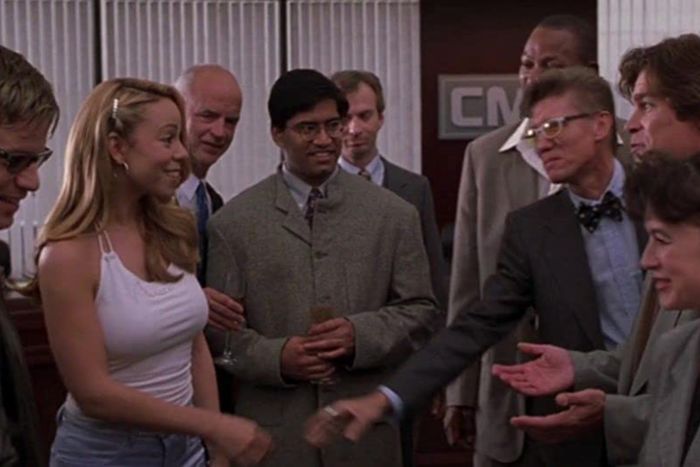
In November 2018, one of the more surprising culture stories involved grassroots activism in the form of — what else? — a hashtag: #JusticeforGlitter. The infamous Mariah Carey bomb was 17 years old, and up to that point, its star had largely rebuked it. But Carey’s zealous fan base, the Lambily, wanted retribution for what they saw as an unfairly maligned chapter of their favorite diva’s career. As the campaign spread across social media, Glitter’s soundtrack reached No. 1 on the iTunes albums chart and returned to the Billboard soundtracks chart. Suddenly, Carey’s biggest flop era was up for reconsideration.
You may or may not recall when the Glitter soundtrack was originally released — 20 years ago, on September 11, 2001. The corresponding movie, plagued by scathing reviews and tabloid-propagated gossip about Carey’s recent hospitalization, opened ten days later, all but guaranteeing its triviality and ushering in the year’s weakest box-office weekend. Glitter drew a feeble $2.4 million, outgrossed by ten holdovers, including Hardball, The Others, The Glass House, Two Can Play That Game, and Rat Race. Two dynamics were working against it at once: Post-9/11, Americans simply weren’t going to the movies, and certainly not to see what had been framed as a slice of celebrity fluff.
On the one hand, the notion of “justice for Glitter” demonstrates the way so-called stans have assigned themselves authority over pop stars’ reputations, an internet phenomenon that tends to reject any criticism, past or present. On the other, it is a tacit admonishment of Y2K-era pop-culture consumption, when the flashy MTV trappings of the rich and famous made it easier for the public at large to relish celebrities’ tribulations. The campaign succeeded in resurrecting the infinitely mocked movie and its music, but to what end? Two decades after Glitter, are we any closer to understanding its legacy? What really was it? An ill-conceived vanity project? A doomed-from-the-start venture forced into the cracks of history by tragedy? A final gush of the celebrity monoculture before social media rewrote the fame game? An unfortunate case of public rubbernecking? All of the above?
To really understand the disastrous post-9/11 rollout of Glitter (originally titled All That Glitters) and the ensuing crusade to restore its reputation, one has to back up a few years before the turn of the millennium, to when Carey was first longing to find big-screen work. “When you are coming from another entertainment world, people really wanna hate on you,” she would say of this period. “They really wanna say, ‘Oh, well, I don’t know, she’s going to take us out of the movie.’” In 1998, Carey signed on to a James Bond spoof called Double-O-Soul opposite a red-hot Chris Tucker, but the film never came to fruition. The following year, she cameoed as an opera singer in the middling Chris O’Donnell–Renée Zellweger rom-com The Bachelor.
Around this time, she attached herself to what would become Glitter, a Star Is Born–esque showbiz drama that Carey developed alongside What’s Love Got to Do With It screenwriter Kate Lanier. (Playwright Cheryl L. West earned a “story by” credit.) “I wrote the treatment,” Carey told Movieline. “It’s a story I’ve wanted to tell for a long time. We start with my character, Billie Frank, as a 9-year-old girl … Billie is sent to live at an orphanage because her mother is unstable. Billie grows up confused, becomes a backup singer for a girl who really can’t sing, and she’s pissed off because she knows she’s so much better. She signs a bad deal, then meets a DJ who falls for her and makes her a star. But he has a very dark side.” (That is, rather succinctly, the entire plot.)
Almost as soon as Glitter entered the public’s consciousness, skepticism arose. Though Carey insisted it wasn’t autobiographical, the movie mirrored details from her life, including Billie’s troubled relationship with her mother, which seeded a perception that Glitter would be a navel-gazing charade. Rumors about the frenetic shoot itself didn’t help: She and Lanier reportedly revised scenes on the set; other moments apparently “came from improvisation.” Carey “convinced” herself that cinematographer Geoffrey Simpson was “shooting me on my bad side on purpose.”
Off set, Carey’s circumstances were more troubling. She was dealing with the stress brought on by two breakups: her 1998 divorce from hypercontrolling Sony Music Entertainment chief Tommy Mottola, followed by her 2001 split with singer Luis Miguel. When Carey left Motola after four tumultuous years of marriage, she signed a reported $80 million contract with Virgin Records. Her first album under that deal was the Glitter soundtrack, a blend of originals and covers that matched the movie’s clubby early-’80s setting. While working on the lead single “Loverboy,” Carey and producer Clark Kent incorporated a sample of Yellow Magic Orchestra’s 1978 electronic jam “Firecracker.” Mottola learned of their interpolation and rushed the sample to Sony darling Jennifer Lopez — “thievery,” Carey called it. And because Carey had recorded a duet with Ja Rule, Mottola recruited producer Irv Gotti to set up a collaboration between the rapper and Lopez. Out of that came their megapopular “I’m Real” remix, which was released ahead of “Loverboy,” effectively forcing Carey to remove the sample. Without the kicky “Firecracker” beat, “Loverboy” turned fairly bland. After endlessly catchy hits like “Honey,” “My All,” and “Heartbreaker,” “Loverboy” paled.
Whatever sympathy existed for Carey’s behind-the-scenes ordeals seemingly dissipated, however, as Glitter’s press blitz kicked off. It started with a July 17 appearance on BET’s 106 & Park, where she described herself as “exhausted” but seemed mostly upbeat. Then came Total Request Live. Glitter’s reviews probably wouldn’t have been any more favorable had Carey not made her quasi-scandalous TRL appearance on July 19 — the movie really isn’t good; don’t @ me — but the widely seen spectacle practically guaranteed its punching-bag status. When her microphoned voice rang out mid-show and she emerged pushing a Popsicle cart, a bamboozled Carson Daly called the appearance “unannounced.” (Fun fact: J.Lo and Ja Rule’s “I’m Real” video had just aired when Carey walked onto the set. Coincidence? Unclear.) In her 2020 memoir The Meaning of Mariah Carey, Carey says Daly may have been caught off guard but the show’s producers weren’t — even before 9/11, there was too much security at MTV’s Times Square building for her to truly crash the joint.
Rewatching the clip today, Carey does seem a little unhinged. “You’re my therapy session right now, Carson,” she tells him. “You see, every now and then, somebody needs a little therapy. And today is that moment for me.” But it hardly feels like the jaw-dropper it was made out to be. TRL, with its screaming teenage crowd, often had a chaotic aura anyway. Daly makes a fuss about her “striptease,” but it’s really just Carey removing an oversize T-shirt that has the word “Loverboy” airbrushed on it. Underneath, she’s wearing a halter top and tight shorts, a typical uniform for young stars circa 2001.
Assumptions about Carey’s erraticism began to take hold anyway. Carey had been working nonstop on limited sleep, too tired to make a second video before the soundtrack’s release. “She was visibly being pulled in a million different directions,” Daly told Entertainment Weekly shortly thereafter. On July 20, Carey attended a Q&A at a Long Island mall. While rambling about “haters,” Carey’s publicist, Cindi Berger, pulled the microphone from Carey’s hand and shuffled her away from the media scrum against Carey’s protests. On July 25, two alarming audio messages surfaced on Carey’s website. One found her saying, “I just want you to know that I’m trying to understand things in life right now and so I really don’t feel that I should be doing music right now. I just can’t trust anybody anymore right now because I don’t understand what’s going on.” They were swiftly removed, and hours later, Carey checked into a hospital. “She has suffered an emotional and physical breakdown,” Berger told the Associated Press. “She is under psychiatric care.”
Every juicy story has a villain, and Mottola’s infantile duplicity led to — among other things — Carey and Lopez’s alleged feud. The New York Post in particular had a field day. “The blow that sent Mariah Carey to the hospital in July with a nervous breakdown was learning that Jennifer Lopez had ‘stolen’ part of her song ‘Loverboy,’” the paper reported, to the extent that the aforementioned sentence constitutes reporting. “A source said, ‘It literally drove her crazy.’” In The Meaning of Mariah, Carey said Mottola sought to “sabotage” Glitter as revenge for their breakup and her Sony departure. (Gotti corroborated Mottola’s crooked ways during a 2017 Desus & Mero interview.) “Tommy and his cronies went as far as taking promotional items, like my stand-up advertisements, out of the record stores,” Carey wrote. “Loverboy” managed to peak at No. 2 on the Billboard Hot 100 despite weak radio play, buoyed by Virgin’s decision to discount the CD single to 49 cents. But it didn’t make a huge dent on MTV.
Plans for Carey to headline the network’s starry 20th-anniversary special were scrapped, as was the Glitter press junket. A box-office analyst said the movie was “tracking very poorly” based on prerelease buzz. As if these events didn’t provide enough pandemonium, paparazzi were chasing after Carey when she left the hospital on August 6. That week, Virgin delayed the soundtrack’s drop date to September 11, and 20th Century Fox pushed the movie from its August 31 release to September 21. Carey flew to Los Angeles to visit her brother, who, according to Carey’s memoir, duped her into a stint at a “hard-core detox and rehab center,” where she was fed “heavy narcotics.” She had agreed to shoot a 20/20 interview with Barbara Walters about her initial hospitalization, but Berger said she needed “more time to rest.” Carey got discharged on the day of the World Trade Center assault. “So I was magically ‘good to go,’ because terrorists had attacked America and a ‘cracked-up diva’ wasn’t interesting anymore? (Hello?!!),” she wrote. She would later seek estrangement from her brother and other unreliable relatives.
No one needs to be reminded that September 11, 2001, was not the best time to release an album. But Jay-Z’s The Blueprint, Nickelback’s Silver Side Up, Bob Dylan’s Love & Theft, Fabulous’s Ghetto Fabulous, and P.O.D.’s Satellite also came out that day, and each of them fared better than Glitter. Carey was one of the best-selling artists in music history, yet Glitter sold a small fraction of her previous work. (Another fun fact: “I’m Real” topped the Hot 100 that week, as if Carey’s wounds needed more salt.) Her well-chronicled struggles — documented on the cover of Us Weekly, in MTV News bulletins, and beyond — had convinced spectators that the whole thing was doomed. Critics’ reviews confirmed those suspicions. They panned Carey’s stilted performance and the movie’s broad, hammy plot, which accentuated Billie’s chemistry-free romance with the DJ (Max Beesley) who brought her fame. “This star vehicle for singer Mariah Carey is primarily a showcase for her breasts,” the Washington Post’s Megan Rosenfeld wrote. “And if they gave out Oscars for body parts, this pair would definitely be contenders.” A New York Times critic said audience members “erupted repeatedly into laughter at scenes intended to carry emotional weight.”
Nonetheless, Carey rallied, making her first public appearance on September 20 at a Glitter screening, sporting a black shirt with a sparkly American flag on it. The next day, Glitter bowed in roughly 1,200 theaters; that night, Carey performed “Hero” at the George Clooney–organized TV benefit America: A Tribute to Heroes. By the end of its theatrical run, the film had collected $4.3 million domestically — less than 20 percent of its reported $22 million budget. But the drama didn’t stop there. Presumably fearing that Carey wouldn’t rebound the way so many pop idols have, EMI — Virgin’s parent company — paid Carey a reported $28 million to dismiss her contract, leaving her without a record deal at a time when digital pirating was slowly eroding CD sales. ”It goes like this. Something like, ‘Industry Rule No. 480: Record-company people are shady,’” she told the New York Times, summoning an A Tribe Called Quest lyric.
Carey spent the beginning of 2002 writing her next album, Charmbracelet. That January, she attended the Sundance Film Festival on behalf of the mobster drama WiseGirls, which she’d shot the previous May. (“This is a person that never, ever relaxes,” producer Anthony Esposito said.) The following month, she performed the national anthem at the Super Bowl. In May, after fielding competing offers, she signed a $7.5 million-per-album deal with Universal Music Group. And in June, her 72-year-old father died of cancer. Charmbracelet’s torchy lead single, “Through the Rain,” detailed Carey’s perseverance. “I can stand up once again / On my own and I know / That I’m strong enough to mend.” She mounted a full-scale promotional bid, including appearances on Larry King Live, The Oprah Winfrey Show, The View, 106 & Park, and the Today show, and embarked on an eight-month world tour that sometimes suffered from sluggish ticket sales.
Everyone loves a comeback, and Carey would land hers eventually, but Charmbracelet wasn’t a massive hit either, its plodding R&B ballads lacking the hooks for which she was known. “Through the Rain” stalled at No. 81. But while promoting Charmbracelet in late 2002, Carey began to reclaim the Glitter narrative. What happened to her was a “meltdown,” yes, but it was not the “nervous breakdown” that many had called it. When Matt Lauer asked her on Dateline about the hospital’s therapeutic methods, she portrayed herself as a bastion of mental health: “Well, first of all, I ended up running the group therapy session and solving everybody else’s problems.” And she decried Glitter as something that defied her intentions: “It started out as a concept with substance, but it ended up being geared to 10-year-olds,” Carey told USA Today. “It lost a lot of grit. It was gritless, in fact. I kind of got in over my head.”
Several years later, during interviews ahead of the release of 2009’s Precious — in which she delivers a performance so natural and affecting it makes you wonder what caused her spiritlessness in Glitter — she’d claim that Glitter had opened on September 11, an approximation that nonetheless helps to illuminate its downfall. “It was a horrible couple of years, and then I had to get my momentum back for people to let it go,” Carey said on Watch What Happens Live in 2013, disclosing that no one in her camp is allowed to mention the film by name, and again citing 9/11. By this time, she’d released The Emancipation of Mimi, an all-time-great pop renaissance that birthed “We Belong Together” and “Shake It Off.” Until 2016, she didn’t sing anything from the Glitter soundtrack on her many tours.
So when #JusticeforGlitter sprang up in 2018, it seemed silly. Maybe the movie and album aren’t as heinous as their initial reception implies, but they’re really not deserving of the restitution that Carey loyalists demanded. The flat dialogue, uninspired pacing, and goofy use of slow motion haven’t improved with time, and most of the songs heard in the film — barring, arguably, Carey’s version of “I Didn’t Mean to Turn You On” — are forgettable at best.
The hashtag ultimately has less to do with the actual material of Glitter and more to do with the culture around it — the late-’90s and early-2000s celebrity worship that could so quickly turn to celebrity loathing, something that has become ripe for relitigation decades later. More and more people have come to the conclusion that Janet Jackson should not be blamed for her exposed breast during the 2004 Super Bowl halftime show when Justin Timberlake was the one who exposed it. Denigrating supposed “bad girls” like Lindsay Lohan and Paris Hilton simply for existing has grown outdated. Recently, another, more efficient hashtag proliferated: #FreeBritney.
When we look back at Glitter, we revisit one of the most uniquely energizing periods in pop-culture history — and one of its most disconcerting. It was a time before the internet monopolized the mechanics of fame and celebrities seized sufficient control over their public images, all but ensuring there would never be another moment quite like Glitter. Hollywood became risk-averse in the aftermath of 9/11, too, and even more so following the 2008-09 economic recession. The industry stopped prioritizing mid-budget, star-driven stand-alone originals targeted at mature audiences, as Marvel and its franchise ilk upended the business, rendering Carey’s whole fracas a bit quaint. Today, pop vocalists desiring to act won’t conjure the same gasps in the age of Mary J. Blige and Lady Gaga’s Oscar nominations.
The post-2018 reappraisal of Glitter is when Carey’s “shit happens” approach to divadom (see: her disastrous performance on Dick Clark’s New Year’s Rockin’ Eve With Ryan Seacrest in 2017) really took hold. After #JusticeforGlitter, Carey tweaked her whole tune: “It’s actually a really good album,” she said on Good Morning America. “I can say it, now that they got it to number one.” She could rewrite her self-perception, no longer anxious to shove her erstwhile passion project into some hall of shame. In the end, Glitter was all sorts of things: a troubled endeavor further imperiled by Carey’s personal trials and a national tragedy that wasn’t even the wildest aspect of its rollout. We needn’t pretend that Glitter is a masterpiece in order to feel that justice has been served. A little empathy for its progenitor will do fine.





